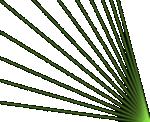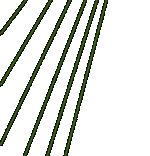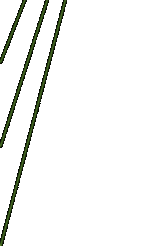Frequently
Asked Questions
Question: If a hologram breaks is the whole
image visible in each piece?
No, each broken piece
would let you see the image from its own unique perspective. Think of a hologram as a
window. Anywhere you look through a window you see what's on the other side. If you were
to paint the window black and scratch a hole in the paint on the left side of that window
just big enough to look through, you would see everything on the other side of the window.
Like looking through a peephole. If you then scratch another viewing peephole somewhere on
the right side of the window, you still can see through, but from a different perspective.
This is the same effect that each broken piece of a hologram would display. Just remember
that if you have two broken pieces taken from opposite sides of the hologram, and you are
looking at an object that looks differently from each side, one piece may let you see just
one of those sides while the other piece will let you view the other side. So, you might
say that each piece of a hologram stores information about the whole image, but from its
own viewing angle. No two pieces will give you a view that is exactly the same.
Question: What media are used for holography?
There are different
kinds of media:
The oldest - silver
halide emulsion. It is an emulsion similar to camera emulsion, but of much higher
resolution. These are excellent for wall pictures, portraits, etc.
Dichromate hologram
(DCG) is made of special gelatin emulsion sealed between two glass plates. It is
mainly used for small earrings, holo-watches, pendants, etc. It offers really bright and
sharp imaging.
Embossed holograms
are the ones on plastic with "silver foil". Embossed holograms are the lowest
priced in large runs. They are used on credit cards, security applications, sports cards,
stickers, etc. Embossed or "rainbow" holograms often are like
multi-color. Color information is computer-generated before embossing process.
Photo-polymer
is relatively new material. It gives very bright image on a flexible surface and requires
easy development procedure. Used for bright wall holograms, keyrings, etc. It may be
transparent - which opens new possibilities.
Question: What are holograms used for?
Holograms have many
uses in art, science and technology. Holograms are used on product packaging at many
stores. Several magazines have featured holograms on their covers. Holograms are found on
credit cards, drivers licenses, and even clothing to help stop counterfeiting.
Computer-generated holograms allow engineers and designers to visually see their creations
like never before.
Engineers also use
holography to test for fractures and also for quality control during manufacturing. It is
called holographic non-destructive testing. Holograms are used in many airplanes, both
civilian and military. These holograms provide the pilot with critical information while
looking through the cockpits window. It is called a heads-up display.
Artists use holography
for artistic expression. Many artists feel that exploring the three-dimensional space and
pure light that holography offers allows them to convey images and messages that were
never before possible with traditional media.
Question: What words describe images appearing
in a hologram?
If an image appears to
be on the other side of the hologram, like looking through a window, it is called virtual.
If an image jumps right out of the hologram and appears in front of the film, it is called
real, since it has left the "virtual" world inside the film and entered the
"real" world. When you flip a hologram over, the image is inside out and called
pseudoscopic. Flip it back over and view it normally, right side out, and it is called
orthoscopic. An image can be orthoscopic and real or orthscopic and virtual. Or an image
can be pseudoscopic and real or pseudoscopic and virtual. An image can be both real and
virtual, as in the case of an image that starts behind the film and then protrudes right
out of it. Holograms can be made (especially by artists) that have both orthoscopic and
pseudoscopic images in them. Any combination of these terms is possible.
Question: How are images made to jump out in
front of the holographic film?
As just explained
in the previous response, images that protrude out in front of a piece of holographic film
are called real images. Virtual image holograms are used as the masters for real image
holograms. Most real image holograms are holograms of holograms. The basic concept is like
the idea that a negative of a negative is a positive. In effect, when you typically make a
hologram it is orthoscopic (right side out) and virtual (the image appears behind the
film). If you turn this orthoscopic and virtual image hologram over the image you see is
both pseudoscopic (inside out) and real (in front) since the spatial relationship of where
the image is seen has flipped. If you usethis image to record a second hologram, that
image will be pseudoscopic (inside out) because you are recoding the pseudoscopic image of
the first hologram and virtual. If you then turn it over it is orthoscopic (right side
out) because an inside out image of an inside out image is right side out and real because
each time you flip a hologram over you reverse from virtual image to real image.
Question: Can I make a hologram using my
favorite photograph?
Yes, and no. It is
possible to make a hologram of photograph, but photograph itself contains flat, 2-D image
information. Therefore on the hologram it will also look flat. It would look just like a
flat photograph floating in the space on front, or behind the frame. The third, missing
dimension of a photograph cannot be reconstructed by holographic process.
Question: Can the holographic image be enlarged or
reduced?
It is possible, but
very complex and expensive. For this reason the natural choice is to create holograms in
1:1 size.
Question: How about full-color holography?
Most of holograms is
made in one color - similar to black and white holography. The typical greenish - yellow
color of a hologram is formed there because of interference of white light on holographic
emulsion, development provides colour variations (from red to bluish). Multi-color
holograms are available, but as it takes extremely complicated process and is time
consuming, they are still rare and expensive. The embossed holograms are like multi-color,
but it is not the "original" color - just a "rainbow" effect.
Question: Will a hologram last long?
Holograms are very
durable, and with proper care will outlive any regular photographs or prints.
Question: How can I view a hologram?
If you purchased your
hologram in one of the shops across your country, chances are it is a "white-light
reflection" hologram. Reflection holograms are popular because you can mat and frame
them, and hang them on your wall. In order to view your reflection hologram, you must
provide a light source to light up the hologram. This light source is commonly located on
your ceiling, such as track lighting. If you do not have track lighting, you may also use
one of the inexpensive "clip-on" lamps.
You should place your
hologram on the wall at a comfortable height - taking into consideration both adults and
children. It is much easier for a tall person to bend down a little than it is for a
shorter person to stretch up to see. A good starting point would be to have the center of
your hologram placed between 150 cm and 170 cm on your wall, measured from the base of the
wall.
Your light source
should come into the hologram at a starting angle of approx. 45 degrees. Different
holograms light up at different angles, but 45 degrees is a good place to start. Have
someone hold the light in place, and then view the hologram from around 2 meters or so
away from the wall. Adjust the incoming angle until you get the best view of the hologram.
It is very important
that you provide the right bulb to light the hologram. The best bulb to use is a clear
halogen bulb. If a halogen bulb is not possible, you should use a clear incandescent bulb.
It is important that the bulb is clear and not frosted. A frosted light source will create
a blurred hologram - as will any flourescent lighting.
If you'd like to
display your hologram on a lamp table, replace your lamp bulb with a clear bulb and have
the hologram angled at a 45-degree angle. While this will not give the quality effect of
having the hologram on the wall with track lighting, it will allow you to enjoy your
hologram if the other methods are not possible. Anyway, clear and pointed light source is
preferable.
|


